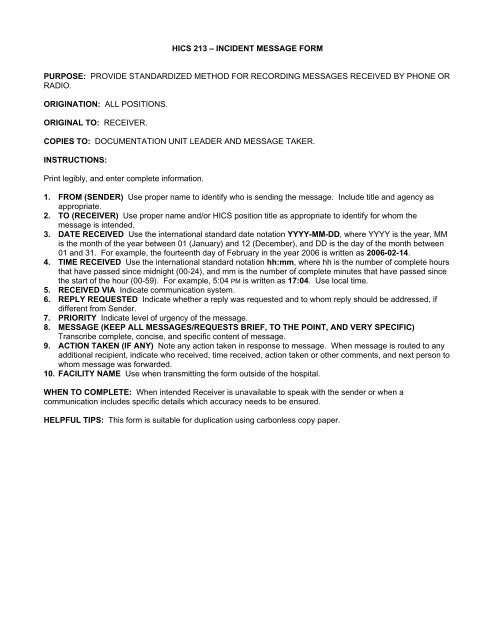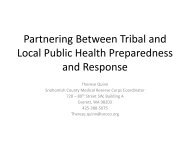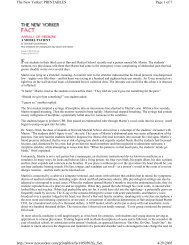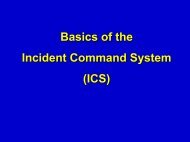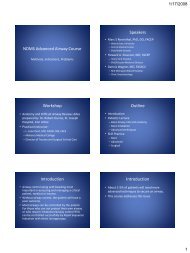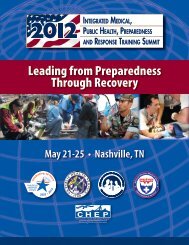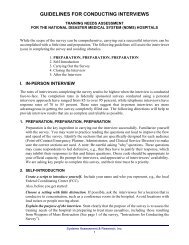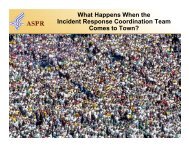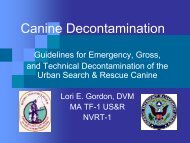Using the HICS Tools in Incident Action Planning - The 2012 ...
Using the HICS Tools in Incident Action Planning - The 2012 ...
Using the HICS Tools in Incident Action Planning - The 2012 ...
You also want an ePaper? Increase the reach of your titles
YUMPU automatically turns print PDFs into web optimized ePapers that Google loves.
<strong>HICS</strong> 213 – INCIDENT MESSAGE FORM<br />
PURPOSE: PROVIDE STANDARDIZED METHOD FOR RECORDING MESSAGES RECEIVED BY PHONE OR<br />
RADIO.<br />
ORIGINATION: ALL POSITIONS.<br />
ORIGINAL TO: RECEIVER.<br />
COPIES TO: DOCUMENTATION UNIT LEADER AND MESSAGE TAKER.<br />
INSTRUCTIONS:<br />
Pr<strong>in</strong>t legibly, and enter complete <strong>in</strong>formation.<br />
1. FROM (SENDER) Use proper name to identify who is send<strong>in</strong>g <strong>the</strong> message. Include title and agency as<br />
appropriate.<br />
2. TO (RECEIVER) Use proper name and/or <strong>HICS</strong> position title as appropriate to identify for whom <strong>the</strong><br />
message is <strong>in</strong>tended.<br />
3. DATE RECEIVED Use <strong>the</strong> <strong>in</strong>ternational standard date notation YYYY-MM-DD, where YYYY is <strong>the</strong> year, MM<br />
is <strong>the</strong> month of <strong>the</strong> year between 01 (January) and 12 (December), and DD is <strong>the</strong> day of <strong>the</strong> month between<br />
01 and 31. For example, <strong>the</strong> fourteenth day of February <strong>in</strong> <strong>the</strong> year 2006 is written as 2006-02-14.<br />
4. TIME RECEIVED Use <strong>the</strong> <strong>in</strong>ternational standard notation hh:mm, where hh is <strong>the</strong> number of complete hours<br />
that have passed s<strong>in</strong>ce midnight (00-24), and mm is <strong>the</strong> number of complete m<strong>in</strong>utes that have passed s<strong>in</strong>ce<br />
<strong>the</strong> start of <strong>the</strong> hour (00-59). For example, 5:04 PM is written as 17:04. Use local time.<br />
5. RECEIVED VIA Indicate communication system.<br />
6. REPLY REQUESTED Indicate whe<strong>the</strong>r a reply was requested and to whom reply should be addressed, if<br />
different from Sender.<br />
7. PRIORITY Indicate level of urgency of <strong>the</strong> message.<br />
8. MESSAGE (KEEP ALL MESSAGES/REQUESTS BRIEF, TO THE POINT, AND VERY SPECIFIC)<br />
Transcribe complete, concise, and specific content of message.<br />
9. ACTION TAKEN (IF ANY) Note any action taken <strong>in</strong> response to message. When message is routed to any<br />
additional recipient, <strong>in</strong>dicate who received, time received, action taken or o<strong>the</strong>r comments, and next person to<br />
whom message was forwarded.<br />
10. FACILITY NAME Use when transmitt<strong>in</strong>g <strong>the</strong> form outside of <strong>the</strong> hospital.<br />
WHEN TO COMPLETE: When <strong>in</strong>tended Receiver is unavailable to speak with <strong>the</strong> sender or when a<br />
communication <strong>in</strong>cludes specific details which accuracy needs to be ensured.<br />
HELPFUL TIPS: This form is suitable for duplication us<strong>in</strong>g carbonless copy paper.


